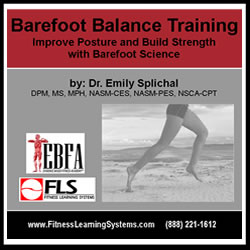
ISBN# 978-1-935746-42-3
Course Description:
In closed chain kinematics the foot is the foundation to human movement. This means that any dysfunction in the foot must impact knee, hip and lower back alignment. Conversely, in open chain kinematics, hip strength controls knee and foot posture. Learn one of the most effective techniques for improving foot posture, controlling knee pain and strengthening the hip. After this course you will fully appreciate the power of barefoot work. Improve posture and build strength - with barefoot balance training.
Education Level: Intermediate - Advanced
Prerequisites: None
Successful completion of the quiz is necessary to receive Continuing Education Credit.
Approved for:
| 0.3 | Action Personal Trainer Certification |
| 3.0 | American College of Sports Medicine (ACSM) |
| 0.3 | American Kinesiotherapy Association (COPS-KT) |
| 0.3 | International Accreditors for Continuing Education and Training (IACET) |
| 1.5 | National Council on Strength & Fitness (NCSF) |
| 0.5 | National Federation of Professional Trainers (NFPT) |
| 3.0 | National Strength Professionals Association (NSPA) |
| 3.0 | YMCA |
Course Objectives:
After completing this course you will be able to:
- Discuss the importance of balance and barefoot training.
- Describe 2 factors necessary to integrate barefoot balance training into a client's program.
- Identify 4 bones and 2 joints associated with the rearfoot.
- Discuss the role of 6 extrinsic muscles and 5 intrinsic muscles in influencing the subtalar, ankle, and foot joints.
- Explain 2 kinematic influences on foot, ankle, and hip function.
- Identify and discuss 4 muscles/muscle groups associated with the hip and how these muscles could affect dysfunction in the hips and feet.
- Describe how single leg stance training affects stabilization, function, activation and balance in the foot, knee, hip and pelvis.
- Discuss the role of neuromuscular influences, maintaining balance, plantar receptor sensitivity, and training surfaces on barefoot balance training.
- Explain how to safely and effectively perform a neuromuscular warm-up, 5 static stabilization exercises, and 6 dynamic stabilization exercises for barefoot balance training.
Other Courses by this author:
System Requirements to View This Course
This course is tablet enabled and can be viewed on an iPad or Android tablet as well as a PC or MAC Computer
